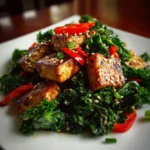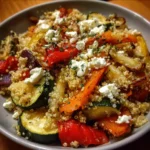The first time I made this Eggplant Chickpea Curry, it was a bit of a gamble. My family has a somewhat… cautious relationship with eggplant, and curries can sometimes be hit or miss depending on the spice level. But let me tell you, this recipe wasn’t just a hit; it was a grand slam! The aroma alone, as it simmered away on the stove – a rich tapestry of toasted spices, creamy coconut milk, and sweet tomatoes – had everyone drifting into the kitchen, asking, “What smells SO good?” The eggplant, which I sometimes find tricky, became incredibly tender and absorbed all the magnificent flavors, transforming into melt-in-your-mouth morsels rather than the spongy texture some fear. The chickpeas added a wonderful, hearty bite and a boost of protein that made the dish incredibly satisfying. Even my usually eggplant-skeptical partner went back for seconds, praising its “surprisingly delicious” texture and rich, complex taste. Since that first success, this Eggplant Chickpea Curry has become a cherished regular in our meal rotation. It’s my go-to for a comforting weeknight dinner that feels a little bit special, perfect for when I want something deeply flavorful, nourishing, and entirely plant-based. It’s also fantastic for entertaining, as it caters to various dietary needs (vegan, gluten-free with the right accompaniments) and always elicits rave reviews. The vibrant colors make it a feast for the eyes as well as the palate. I’ve tweaked it here and there over time, and the version I’m sharing today is, in my humble opinion, absolute perfection. It balances warmth, spice, creaminess, and a subtle tang in a way that will have you scraping the bowl clean.
Ingredients
- 1 large Eggplant (approx. 1.5 lbs / 675g): Choose a firm, glossy eggplant. This is the star, providing a meaty texture and soaking up the curry’s rich flavors.
- 1 tbsp Olive Oil (or Coconut Oil): For sautéing the aromatics and browning the eggplant.
- 1 large Onion (finely chopped): Forms the aromatic base of the curry, adding sweetness and depth.
- 3-4 cloves Garlic (minced): A crucial aromatic that adds pungent, savory notes.
- 1-inch piece Ginger (grated or minced): Adds warmth and a zesty, spicy kick.
- 1 Green Chili (or Red Chili, finely chopped, optional): For a touch of heat; adjust to your preference. Deseed for less spice.
- 1 tsp Cumin Seeds: Toasted whole, these add an earthy, warm flavor.
- 1 tsp Ground Coriander: Provides a mild, citrusy, and slightly sweet undertone.
- 1 tsp Ground Turmeric: Imparts a vibrant yellow color and a warm, earthy, slightly bitter flavor.
- ½ tsp Smoked Paprika (optional, but recommended): Adds a lovely smoky depth.
- ¼ – ½ tsp Cayenne Pepper (or Red Chili Powder, optional): For additional controlled heat.
- 1 (14.5 oz / 400g) can Diced Tomatoes (undrained): Adds acidity, sweetness, and body to the sauce.
- 1 (15 oz / 425g) can Chickpeas (rinsed and drained): Provides protein, fiber, and a satisfying texture. Also known as garbanzo beans.
- 1 (13.5 oz / 400ml) can Full-Fat Coconut Milk: Creates a creamy, rich, and luscious sauce. Full-fat is key for the best texture and flavor.
- 1 tbsp Tomato Paste: Concentrated tomato flavor that deepens the sauce’s umami.
- 1 tsp Garam Masala: A warming blend of spices added towards the end to preserve its aromatic qualities.
- Juice of ½ Lemon (or Lime): Brightens up all the flavors and adds a fresh, zesty finish.
- Salt, to taste: Essential for enhancing all other flavors.
- Fresh Cilantro (chopped, for garnish): Adds a fresh, herbaceous note and visual appeal.
- Cooked Basmati Rice or Naan Bread, for serving: The perfect accompaniments to soak up the delicious curry sauce.
Instructions
- Prepare the Eggplant:
- Wash the eggplant thoroughly. Trim off the stem and bottom ends.
- Cut the eggplant into 1-inch cubes. Some people prefer to peel the eggplant, but the skin adds a nice texture and contains nutrients, so I usually leave it on for this curry.
- Optional Step – Salting: Place the eggplant cubes in a colander, sprinkle generously with about 1 teaspoon of salt, and toss to coat. Let it sit for 20-30 minutes over a bowl or in the sink. This draws out excess moisture and some bitterness, resulting in a creamier texture when cooked. After 30 minutes, rinse the eggplant cubes thoroughly under cold water to remove the salt, then pat them very dry with paper towels or a clean kitchen towel. If you’re short on time, you can skip this step, but it does improve the final texture of the eggplant.
- Sauté Aromatics:
- Heat the olive oil (or coconut oil) in a large, heavy-bottomed pot or Dutch oven over medium heat.
- Once the oil is shimmering, add the cumin seeds. Let them sizzle for about 30 seconds until they become fragrant and slightly darker. Be careful not to burn them.
- Add the chopped onion and sauté for 5-7 minutes, stirring occasionally, until softened and translucent.
- Stir in the minced garlic, grated ginger, and finely chopped green chili (if using). Cook for another 1-2 minutes until fragrant. Don’t let the garlic burn.
- Bloom Spices & Cook Eggplant:
- Add the ground coriander, ground turmeric, smoked paprika (if using), and cayenne pepper (if using) to the pot. Stir constantly for about 1 minute. This “blooming” of the spices in oil enhances their flavor and aroma.
- Add the eggplant cubes to the pot. Stir well to coat them with the spices and aromatics.
- Cook the eggplant for 8-10 minutes, stirring occasionally, until it starts to soften and lightly brown on the edges. If the pot seems too dry, you can add a tablespoon or two of water or a little more oil to prevent sticking. The eggplant will absorb quite a bit of oil initially.
- Build the Curry Sauce:
- Stir in the tomato paste and cook for 1 minute, stirring constantly. This helps to cook out the raw taste of the paste and deepen its flavor.
- Add the can of diced tomatoes (undrained) and the rinsed and drained chickpeas. Stir everything together to combine.
- Pour in the full-fat coconut milk. Stir well, scraping up any browned bits from the bottom of the pot – these are packed with flavor!
- Season with salt to your taste. Remember that the eggplant was salted if you did that step, so adjust accordingly. You can always add more salt later.
- Simmer the Curry:
- Bring the curry to a gentle simmer. Once simmering, reduce the heat to low, cover the pot, and let it cook for 20-25 minutes, or until the eggplant is completely tender and the flavors have melded.
- Stir occasionally to prevent sticking and to ensure even cooking. The sauce should thicken slightly during this time. If it becomes too thick for your liking, you can add a splash of water or vegetable broth.
- Finish and Serve:
- Once the eggplant is tender and the curry has reached your desired consistency, stir in the garam masala and the juice of ½ lemon (or lime). The garam masala is added at the end to preserve its delicate aromas, and the lemon juice brightens all the flavors.
- Taste the curry and adjust seasonings if necessary. You might want to add more salt, a pinch of sugar if the tomatoes are too acidic, or a bit more chili powder for extra heat.
- Ladle the hot Eggplant Chickpea Curry into bowls.
- Garnish generously with freshly chopped cilantro.
- Serve immediately with fluffy basmati rice, warm naan bread, roti, or quinoa for a complete and delicious meal.
Nutrition Facts
- Servings: 4-6 servings
- Calories per serving (approximate, for 6 servings): 350-400 kcal
- Fiber: High in dietary fiber from eggplant and chickpeas, promoting digestive health and satiety.
- Plant-Based Protein: A good source of plant-based protein, primarily from the chickpeas, essential for muscle repair and growth.
- Vitamins & Minerals: Contains beneficial vitamins like Vitamin C (from tomatoes and lemon) and minerals like manganese and potassium (from eggplant).
- Healthy Fats: Provides healthy fats from coconut milk and olive oil, important for nutrient absorption and energy.
- Low Cholesterol: Naturally cholesterol-free, making it a heart-healthy option.
(Note: Exact nutritional values can vary based on specific ingredients, brands, and portion sizes.)
Preparation time
- Total Preparation and Cooking Time: Approximately 1 hour to 1 hour 15 minutes. This includes 15-20 minutes for chopping and preparation (or 40-50 minutes if salting the eggplant), and 45-55 minutes for cooking. This makes it a feasible option for a weeknight meal if you manage your time efficiently, or a relaxed weekend cooking project.
How to Serve
This Eggplant Chickpea Curry is wonderfully versatile and can be served in numerous delightful ways. Here are some suggestions to enhance your dining experience:
- Classic Grain Pairings:
- Basmati Rice: The most traditional pairing. Fluffy, fragrant basmati rice is perfect for soaking up the rich curry sauce.
- Brown Rice: For a healthier, more fiber-rich option, serve with cooked brown rice.
- Quinoa: A protein-packed, gluten-free alternative that complements the curry beautifully.
- Jeera Rice (Cumin Rice): Rice flavored with cumin seeds and other whole spices adds an extra layer of aromatic complexity.
- Breads for Dipping:
- Naan Bread: Soft, pillowy naan (plain, garlic, or butter) is ideal for scooping up every last bit of the delicious sauce.
- Roti or Chapati: Whole wheat flatbreads are a lighter alternative to naan and equally good for dipping.
- Pita Bread: Toasted pita bread can also be a great accompaniment.
- Paratha: Flaky, layered Indian bread offers a rich and satisfying texture.
- Flavorful Toppings & Garnishes:
- Fresh Cilantro: A generous sprinkle of chopped fresh cilantro is almost essential for its fresh, herbaceous lift.
- Fresh Mint: A little chopped mint can add another layer of freshness.
- Lemon or Lime Wedges: Serve with extra wedges on the side for those who like an extra citrusy zing.
- Plain Yogurt (Dairy or Non-Dairy): A dollop of plain yogurt (or coconut yogurt for a vegan option) can add a cooling contrast to the warmth of the curry.
- Toasted Nuts or Seeds: A sprinkle of toasted cashews, almonds, or pumpkin seeds can add a delightful crunch.
- Crispy Fried Onions: For an extra layer of savory flavor and texture.
- Pickled Onions: A tangy counterpoint that cuts through the richness.
- Complementary Side Dishes:
- Simple Green Salad: A light salad with a lemon vinaigrette can provide a refreshing contrast.
- Cucumber Raita: A cooling yogurt-based side dish with grated cucumber, mint, and roasted cumin powder.
- Kachumber Salad: A simple Indian salad made with chopped cucumbers, tomatoes, onions, and a lemon-cilantro dressing.
- Mango Chutney or other Pickles: Sweet, spicy, or tangy chutneys and pickles can add another dimension of flavor.
- Serving Presentation:
- Serve in individual bowls or a large communal dish.
- For a vibrant look, swirl a little extra coconut milk or a drizzle of chili oil on top before adding the cilantro.
Additional tips
- Choosing the Perfect Eggplant: Opt for eggplants that are firm to the touch, with smooth, shiny skin and a vibrant, deep purple color. Avoid any with soft spots, bruises, or wrinkled skin. Smaller to medium-sized eggplants often have fewer seeds and a more tender flesh compared to very large ones. Varieties like Globe, Italian, or Graffiti eggplants work well for this curry.
- The Salting Debate (Eggplant): While I mentioned salting as optional, it can make a difference, especially if you’ve had issues with bitter or overly spongy eggplant in the past. Salting draws out excess moisture, leading to a creamier texture and slightly less oil absorption during cooking. If you’re using fresh, young eggplants, you might get away without it. If you skip salting, ensure you pat the eggplant very dry after cubing.
- Customizing Spice Levels: This recipe offers a moderate warmth. To make it milder, omit the fresh green chili and cayenne pepper entirely, and ensure your garam masala isn’t too fiery. For a spicier curry, increase the amount of fresh chili (use hotter varieties like bird’s eye), add more cayenne pepper, or even a pinch of red pepper flakes. Always taste and adjust.
- Achieving Maximum Creaminess: Full-fat coconut milk is non-negotiable for the creamiest sauce. Light coconut milk will result in a thinner, less rich curry. For an even richer, more decadent curry, you can stir in a tablespoon or two of cashew cream (soaked cashews blended with water) towards the end of cooking.
- Sneak in More Vegetables: This curry is very adaptable! Feel free to add other vegetables along with the eggplant or to supplement it. Good additions include:
- Spinach or Kale: Stir in a few handfuls during the last 5-10 minutes of simmering until wilted.
- Bell Peppers (any color): Add cubed bell peppers along with the eggplant.
- Sweet Potatoes or Butternut Squash: Cube and add them earlier, as they take longer to cook, or par-cook them before adding.
- Zucchini or Yellow Squash: Add cubed zucchini in the last 15 minutes of cooking.
- Green Beans or Peas: Add fresh or frozen green beans/peas in the last 10-15 minutes.
- Make-Ahead and Storage: This Eggplant Chickpea Curry tastes even better the next day as the flavors meld and deepen.
- Refrigerate: Allow the curry to cool completely, then transfer it to an airtight container. It can be stored in the refrigerator for up to 3-4 days.
- Reheating: Reheat gently on the stovetop over medium-low heat, stirring occasionally, until warmed through. You may need to add a splash of water or coconut milk if it has thickened too much. Alternatively, reheat in the microwave.
- Freezing Instructions: Yes, this curry freezes well!
- Allow the curry to cool completely.
- Portion it into freezer-safe containers or heavy-duty freezer bags.
- It can be frozen for up to 2-3 months.
- Thawing & Reheating: Thaw overnight in the refrigerator. Reheat as per the instructions above. The texture of the eggplant might be slightly softer after freezing and reheating, but it will still be delicious. Avoid adding fresh cilantro before freezing; add it after reheating.
- Boosting Flavors – The Little Extras:
- Toast Whole Spices: If you have whole coriander or cumin, toasting them lightly in a dry pan before grinding them will significantly enhance their aroma and flavor.
- A Pinch of Sweetness: If your tomatoes are particularly acidic, or if you just like a more balanced flavor profile, a tiny pinch of sugar, brown sugar, or a teaspoon of maple syrup can work wonders to round out the flavors.
- Deglaze: When you add the diced tomatoes or a splash of broth, make sure to scrape the bottom of the pot to lift any browned bits (fond). This adds immense flavor.
- Don’t Rush the Simmer: Allowing the curry to simmer gently for the recommended time is crucial for the flavors to meld and the eggplant to become perfectly tender.
FAQ section
- Q: Can I make this Eggplant Chickpea Curry without coconut milk?
A: Yes, while full-fat coconut milk provides the signature creaminess, you can make substitutions. For a creamy alternative, try blending soaked raw cashews with water to make cashew cream and stir it in towards the end. You could also use a thick, unsweetened plant-based milk like oat or soy milk, but you might need to add a thickener like a cornstarch slurry (1 tablespoon cornstarch mixed with 2 tablespoons cold water) during the last few minutes of simmering to achieve a comparable consistency. The flavor profile will be slightly different but still delicious. Evaporated milk (if not vegan) can also work. - Q: Is this recipe gluten-free?
A: Yes, this Eggplant Chickpea Curry recipe is naturally gluten-free as written, provided you ensure all your packaged ingredients (like spices, tomato paste, and coconut milk) are certified gluten-free and there’s no cross-contamination during preparation. Serve it with gluten-free accompaniments like rice or quinoa instead of naan bread (unless using gluten-free naan). - Q: Can I use canned eggplant instead of fresh?
A: It’s generally not recommended to use canned eggplant for this recipe. Canned eggplant is often pre-cooked and packed in brine or oil, and its texture is usually very soft, sometimes mushy. It won’t hold up well during the simmering process and won’t absorb the flavors in the same way fresh eggplant does. Using fresh eggplant is key to achieving the desired texture and taste in this curry. - Q: How do I prevent my eggplant from getting too mushy?
A: There are a few tricks:- Salting: As mentioned in the tips, salting the eggplant helps draw out excess moisture, which can contribute to a less mushy texture.
- Browning: Sautéing the eggplant cubes until they are nicely browned on the edges before adding the liquids helps them develop a slight crust and retain some structure.
- Don’t Overcook: While you want the eggplant tender, avoid simmering the curry for an excessively long time after the eggplant has reached the desired tenderness.
- Cube Size: Ensure your eggplant cubes are not too small (around 1-inch is good). Smaller pieces cook faster and can break down more easily.
- Q: What’s the best type of chickpea to use – canned or dried?
A: Canned chickpeas are perfectly fine and offer convenience for this recipe. Just be sure to rinse and drain them well to remove excess sodium and the liquid they are packed in. If you prefer to use dried chickpeas, you’ll need to soak them overnight and then cook them until tender before adding them to the curry. Using dried chickpeas cooked from scratch can offer a slightly better texture and flavor, but it adds significant preparation time. Approximately ¾ cup of dried chickpeas will yield about 1.5 to 2 cups cooked, equivalent to one can. - Q: Can I make this Eggplant Chickpea Curry oil-free?
A: Yes, you can adapt this recipe to be oil-free. To sauté the onions, garlic, and ginger, use a few tablespoons of water or vegetable broth instead of oil, adding more as needed to prevent sticking. You might also consider roasting the eggplant cubes separately (without oil, on parchment paper) until tender and then adding them to the curry towards the end. The overall richness and some flavor aspects might be slightly different, but it will still be a healthy and tasty dish. - Q: My curry is too watery. How can I thicken it?
A: If your curry is thinner than you’d like, there are a few ways to thicken it:- Simmer Uncovered: Remove the lid and continue to simmer the curry over low to medium-low heat, allowing some of the excess liquid to evaporate. Stir occasionally.
- Cornstarch Slurry: Mix 1 tablespoon of cornstarch with 2 tablespoons of cold water until smooth. Stir this slurry into the simmering curry and cook for a few more minutes until it thickens.
- Mash Some Chickpeas/Eggplant: Lightly mash some of the cooked chickpeas or eggplant pieces against the side of the pot with a spoon. This releases their starches and can help thicken the sauce naturally.
- Add More Coconut Milk/Cream: If you have extra coconut milk or some coconut cream, adding a bit more can increase richness and thickness.
- Q: My curry tastes a bit flat. How can I enhance the flavor?
A: If your curry isn’t as vibrant as you’d like, try these flavor boosters:- Salt: Often, the culprit is simply not enough salt. Taste and add more, a little at a time.
- Acidity: A fresh squeeze of lemon or lime juice at the end makes a huge difference in brightening flavors. You might need a bit more.
- Sweetness: A tiny pinch of sugar or a dash of maple syrup can balance the acidity of the tomatoes and round out the spice profile.
- Garam Masala: Ensure you added it towards the end. You could add another pinch if desired.
- Heat: If you like a bit more kick, a little more cayenne or fresh chili can liven things up.
- Umami: A teaspoon of soy sauce or tamari (for gluten-free) can add depth, though be mindful it will slightly alter the traditional flavor.
- Fresh Herbs: Don’t underestimate the power of fresh cilantro stirred in and garnished on top.

Eggplant Chickpea Curry
Ingredients
- 1 large Eggplant (approx. 1.5 lbs / 675g): Choose a firm, glossy eggplant. This is the star, providing a meaty texture and soaking up the curry’s rich flavors.
- 1 tbsp Olive Oil (or Coconut Oil): For sautéing the aromatics and browning the eggplant.
- 1 large Onion (finely chopped): Forms the aromatic base of the curry, adding sweetness and depth.
- 3–4 cloves Garlic (minced): A crucial aromatic that adds pungent, savory notes.
- 1-inch piece Ginger (grated or minced): Adds warmth and a zesty, spicy kick.
- 1 Green Chili (or Red Chili, finely chopped, optional): For a touch of heat; adjust to your preference. Deseed for less spice.
- 1 tsp Cumin Seeds: Toasted whole, these add an earthy, warm flavor.
- 1 tsp Ground Coriander: Provides a mild, citrusy, and slightly sweet undertone.
- 1 tsp Ground Turmeric: Imparts a vibrant yellow color and a warm, earthy, slightly bitter flavor.
- ½ tsp Smoked Paprika (optional, but recommended): Adds a lovely smoky depth.
- ¼ – ½ tsp Cayenne Pepper (or Red Chili Powder, optional): For additional controlled heat.
- 1 (14.5 oz / 400g) can Diced Tomatoes (undrained): Adds acidity, sweetness, and body to the sauce.
- 1 (15 oz / 425g) can Chickpeas (rinsed and drained): Provides protein, fiber, and a satisfying texture. Also known as garbanzo beans.
- 1 (13.5 oz / 400ml) can Full-Fat Coconut Milk: Creates a creamy, rich, and luscious sauce. Full-fat is key for the best texture and flavor.
- 1 tbsp Tomato Paste: Concentrated tomato flavor that deepens the sauce’s umami.
- 1 tsp Garam Masala: A warming blend of spices added towards the end to preserve its aromatic qualities.
- Juice of ½ Lemon (or Lime): Brightens up all the flavors and adds a fresh, zesty finish.
- Salt, to taste: Essential for enhancing all other flavors.
- Fresh Cilantro (chopped, for garnish): Adds a fresh, herbaceous note and visual appeal.
- Cooked Basmati Rice or Naan Bread, for serving: The perfect accompaniments to soak up the delicious curry sauce.
Instructions
- Prepare the Eggplant:
- Wash the eggplant thoroughly. Trim off the stem and bottom ends.
- Cut the eggplant into 1-inch cubes. Some people prefer to peel the eggplant, but the skin adds a nice texture and contains nutrients, so I usually leave it on for this curry.
- Optional Step – Salting: Place the eggplant cubes in a colander, sprinkle generously with about 1 teaspoon of salt, and toss to coat. Let it sit for 20-30 minutes over a bowl or in the sink. This draws out excess moisture and some bitterness, resulting in a creamier texture when cooked. After 30 minutes, rinse the eggplant cubes thoroughly under cold water to remove the salt, then pat them very dry with paper towels or a clean kitchen towel. If you’re short on time, you can skip this step, but it does improve the final texture of the eggplant.
- Sauté Aromatics:
- Heat the olive oil (or coconut oil) in a large, heavy-bottomed pot or Dutch oven over medium heat.
- Once the oil is shimmering, add the cumin seeds. Let them sizzle for about 30 seconds until they become fragrant and slightly darker. Be careful not to burn them.
- Add the chopped onion and sauté for 5-7 minutes, stirring occasionally, until softened and translucent.
- Stir in the minced garlic, grated ginger, and finely chopped green chili (if using). Cook for another 1-2 minutes until fragrant. Don’t let the garlic burn.
- Bloom Spices & Cook Eggplant:
- Add the ground coriander, ground turmeric, smoked paprika (if using), and cayenne pepper (if using) to the pot. Stir constantly for about 1 minute. This “blooming” of the spices in oil enhances their flavor and aroma.
- Add the eggplant cubes to the pot. Stir well to coat them with the spices and aromatics.
- Cook the eggplant for 8-10 minutes, stirring occasionally, until it starts to soften and lightly brown on the edges. If the pot seems too dry, you can add a tablespoon or two of water or a little more oil to prevent sticking. The eggplant will absorb quite a bit of oil initially.
- Build the Curry Sauce:
- Stir in the tomato paste and cook for 1 minute, stirring constantly. This helps to cook out the raw taste of the paste and deepen its flavor.
- Add the can of diced tomatoes (undrained) and the rinsed and drained chickpeas. Stir everything together to combine.
- Pour in the full-fat coconut milk. Stir well, scraping up any browned bits from the bottom of the pot – these are packed with flavor!
- Season with salt to your taste. Remember that the eggplant was salted if you did that step, so adjust accordingly. You can always add more salt later.
- Simmer the Curry:
- Bring the curry to a gentle simmer. Once simmering, reduce the heat to low, cover the pot, and let it cook for 20-25 minutes, or until the eggplant is completely tender and the flavors have melded.
- Stir occasionally to prevent sticking and to ensure even cooking. The sauce should thicken slightly during this time. If it becomes too thick for your liking, you can add a splash of water or vegetable broth.
- Finish and Serve:
- Once the eggplant is tender and the curry has reached your desired consistency, stir in the garam masala and the juice of ½ lemon (or lime). The garam masala is added at the end to preserve its delicate aromas, and the lemon juice brightens all the flavors.
- Taste the curry and adjust seasonings if necessary. You might want to add more salt, a pinch of sugar if the tomatoes are too acidic, or a bit more chili powder for extra heat.
- Ladle the hot Eggplant Chickpea Curry into bowls.
- Garnish generously with freshly chopped cilantro.
- Serve immediately with fluffy basmati rice, warm naan bread, roti, or quinoa for a complete and delicious meal.
Nutrition
- Serving Size: one normal portion
- Calories: 400






